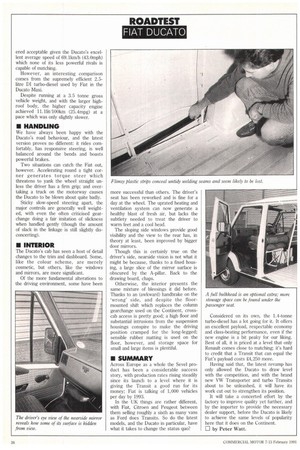ROADTEST FIAT DUCAT°
Page 34

If you've noticed an error in this article please click here to report it so we can fix it.
ered acceptable given the Ducato's excellent average speed of 69.1km/h (43.0mph) which none of its less powerful rivals is capable of matching.
However, an interesting comparison comes from the supremely efficient 2.5Litre DI turbo-diesel used by Fiat in the Ducat° Maxi.
Despite running at a 3.5 tonne gross vehicle weight, and with the larger highroof body, the higher capacity engine achieved 11.11it/100km (25.4mpg) at a pace which was only slightly slower.
• HANDLING
We have always been happy with the Ducato's road behaviour, and the latest version proves no different: it rides comfortably, has responsive steering, is well balanced around the bends and boasts powerful brakes, Two situations can catch the Fiat out, however. Accelerating round a tight corner generates torque steer which threatens to yank the wheel straight unless the driver has a firm grip; and overtaking a truck on the motorway causes the Dumto to be blown about quite badly.
Sticky slow-speed steering apart, the major controls are generally well weighted, with even the often criticised gearchange doing a fair imitation of slickness when handled gently (though the amount of slack in the linkage is still slightly disconcerting).
• INTERIOR
The Ducato's cab has seen a host of detail changes to the trim and dashboard. Some, like the colour scheme, are merely cosmetic, but others, like the windows and mirrors, are more significant.
Of the more fundamental alterations to the driving environment, some have been more successful than others. The driver's seat has been reworked and is fine for a day at the wheel. The uprated heating and ventilation system can now generate a healthy blast of fresh air, but lacks the subtlety needed to treat the driver to warm feet and a cool head.
The sloping side windows provide good visibility and the view to the rear has, in theory at least, been improved by bigger door mirrors.
Though this is certainly true on the driver's side, nearside vision is not what it might be because, thanks to a fixed housing, a large slice of the mirror surface is obscured by the A-pillar. Back to the drawing board, chaps.
Otherwise, the interior presents the same mixture of blessings it did before. Thanks to an (awkward) handbrake on the 'wrong' side, and despite the floormounted shift which replaces the column gearchange used on the Continent, crosscab access is pretty good; a high floor and substantial intrusions from the suspension housings conspire to make the driving position cramped for the long-legged; sensible rubber matting is used on the floor, however, and storage space for small and large items is plentiful.
• SUMMARY
Across Europe as a whole the Sevel product has been a considerable success story, with production rates rising steadily since its launch to a level where it is giving the Transit a good run for its money; Fiat is talking of 1,000 vehicles per day by 1993.
In the UK things are rather different, with Fiat, Citroen and Peugeot between them selling roughly a sixth as many vans as Ford does Transits, So do the latest models, and the Ducat° in particular, have what it takes to change the status quo? Considered on its own, the 1.4-tonne turbo-diesel has a lot going for it. It offers an excellent payload, respectable economy and class-beating performance, even if the new engine is a bit peaky for our liking. Best of all, it is priced at a level that only Renault comes close to matching; it's hard to credit that a Transit that can equal the Fiat's payload costs 24,250 more.
Having said that, the latest revamp has only allowed the Ducat° to draw level with the competition, and with the brand new VW 'Transporter and turbo Transits about to be unleashed, it will have its work cut out to strengthen its position.
It will take a concerted effort by the factory to improve quality yet further, and by the importer to provide the necessary dealer support, before the Ducato is likely to achieve the same levels of popularity here that it does on the Continent.
by Peter Watt.




















































































































